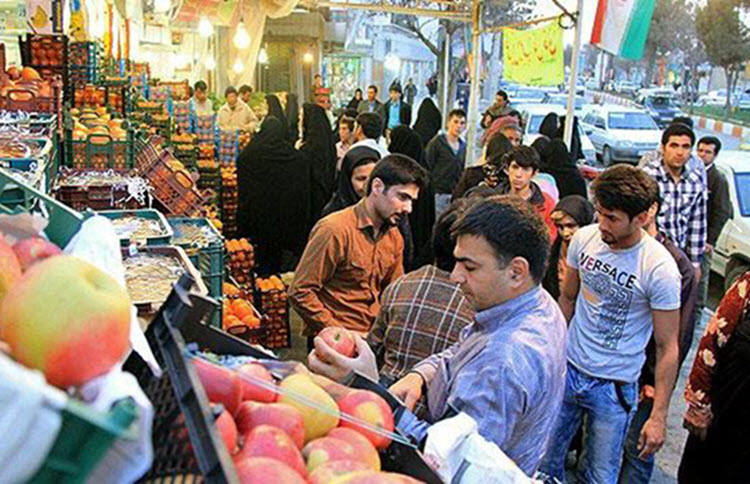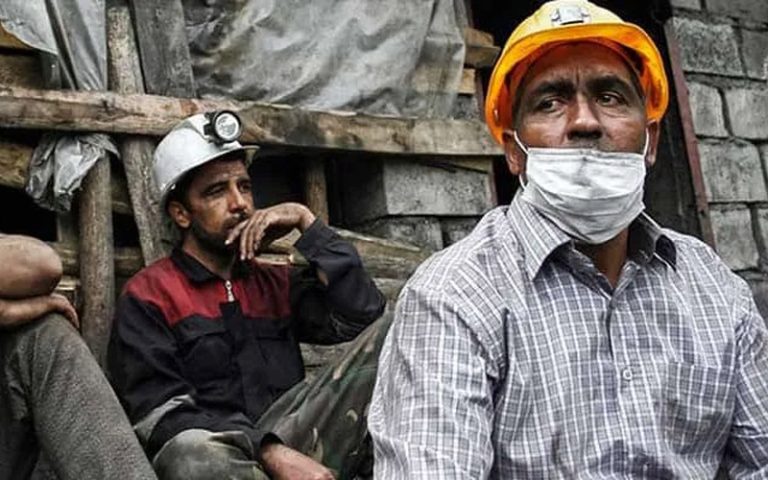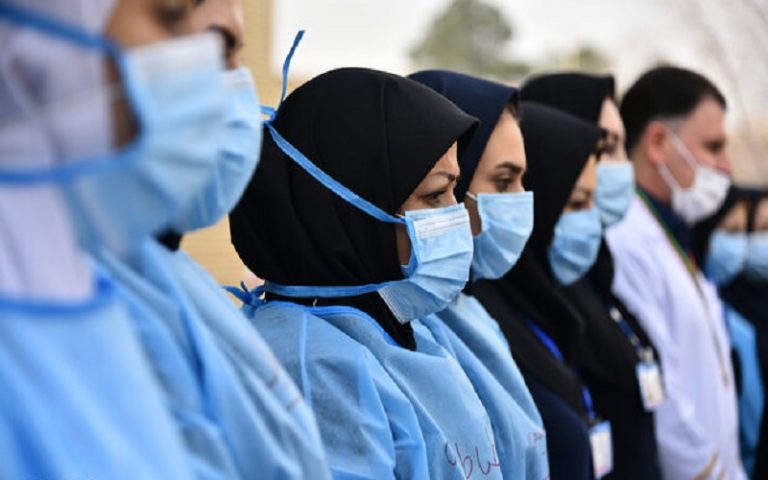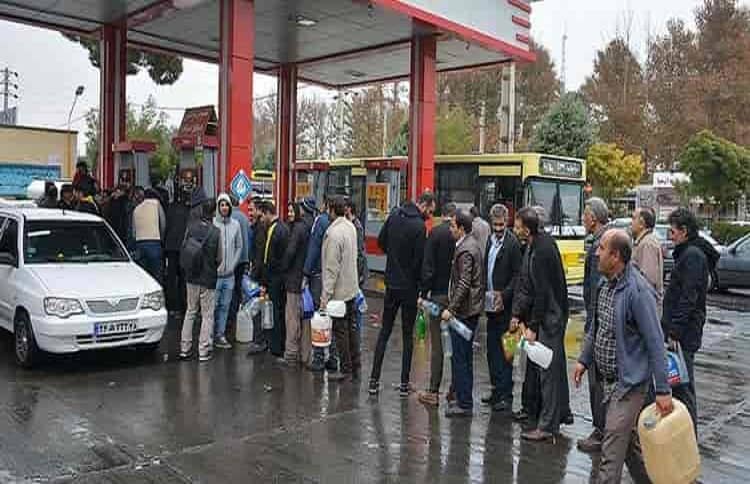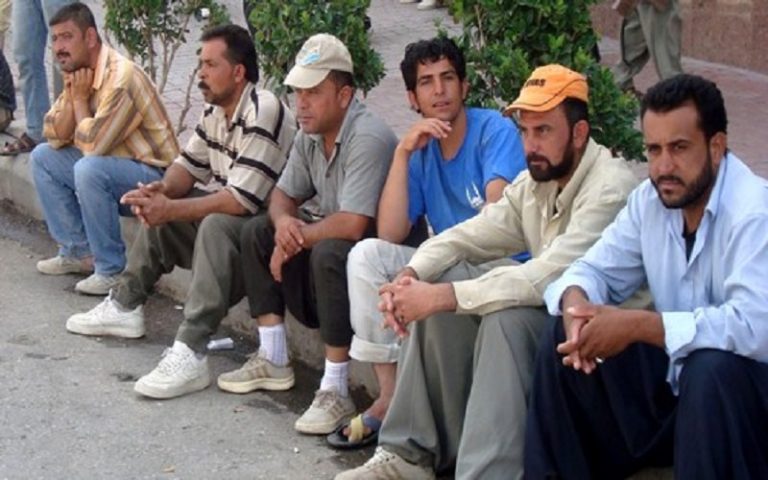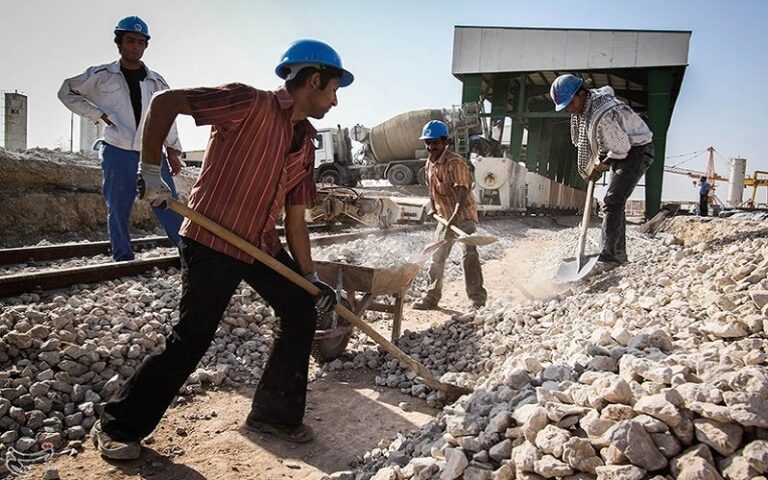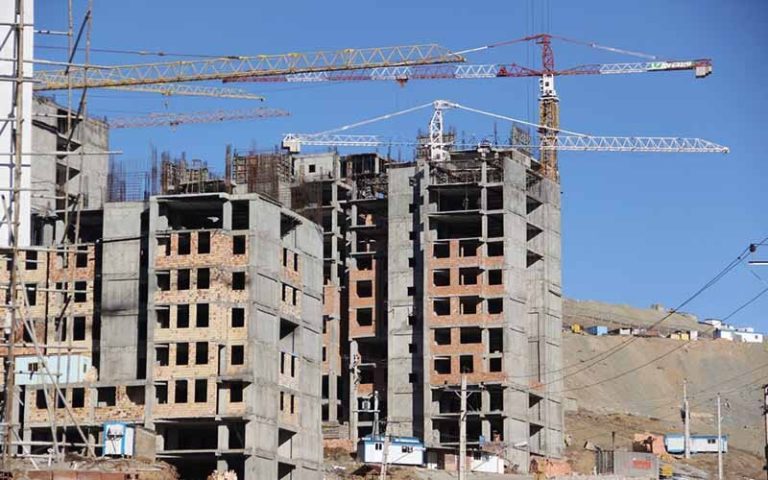Land Subsidence in Critical Conditions in Isfahan
Mehdi Toghyani, a member of the Iranian regime’s Majlis (parliament), pointed to the occurrence of land subsidence in various parts of Isfahan and the danger of the city’s history and civilization, said the danger was so serious that “if there is no thought about it in the next few years, we should all leave Isfahan.”
Toghyani told the state-run Khabar Online website on March 28, “The lack of revival of Zayandehrud has emptied the aquifers of Isfahan plain and has caused socio-economic and environmental problems for Isfahan.”
According to this MP, the problem of Zayandehrud is not only the problem of East Isfahan and the farmers, but the whole plain of Isfahan is in danger of subsidence due to the drought of the Central Plateau River of Iran.
A number of experts believe that the subsidence in Isfahan has passed the warning stage and special measures should be taken for it.
In this regard, images of the creation of a sinkhole caused by subsidence on February 28 show that the deepest landfall in Isfahan has been recorded in the neighborhood of Kojan at six meters.
The regime’s official IRNA news agency in response to the subsidence in Isfahan province and the increasing warnings about this phenomenon, has devoted a section to subsidence news and wrote that subsidence has severely affected many plains of Isfahan province and in this situation, subsidence has exceeded the crisis.
According to IRNA, Isfahan Plain as one of the most important plains of this province on average 15 centimeters per year sinks and the population of two and a half million, urban infrastructure and monuments of this “central plateau” are in serious danger.
In July 2023, the Director General of Disaster Management of Isfahan Governorate had announced that surveying and the Center for Road and Housing and Urban Development Research had been evaluated, and the rate calculated in the plains by Geological Survey has been set between 5 and 18 cm per year in different regions.
An official for Iran’s National Cartographic Center also reported the expansion of land subsidence into cities in January 2024, saying that the phenomenon was advancing in Isfahan and in a city like Arak, central Iran.
The Director General of geodesy and National Cartographic Center had announced that the subsidence in Iran is five times the global average, and currently many provinces, including Markazi and Hamedan provinces, as well as 300 plains of Iran, are suffering from a land depletion crisis.
The regime’s Ham-Mihan newspaper also reported on the crisis of subsidence in Isfahan on January 1, and wrote that there are neighborhoods in Isfahan where all buildings are cracked, and hands pass through them; buildings that are not very old and only 10 or 20 years have passed since they were built.
The newspaper emphasized that the evidence shows that “the subsidence not only affects historical monuments such as Sayed Mosque, Naqsh-e Jahan Square, historical bridges, etc. It has also involved residential, hospitals, schools and urban infrastructure.”
Excessive water harvesting from underground aquifers as well as neglecting the necessity of protecting environmental resources has caused subsidence in most parts of Iran, with Fars news agency reporting in July 2023 that “The dreaded record of land subsidence in some parts of our country has reached 100 times higher than international standards, and conditions in many provinces, including Yazd, are declared critical to the extent that in some regions, the sinkholes have reached within a few hundred meters of people’s homes.”
Iran’s Actual Inflation Rate Higher Than Official Stats
The state-run Donya-e-eqtesad newspaper, in a report analyzing the “general sentiment” regarding inflation in 2023, has stated that households experienced much higher inflation in areas such as clothing, housing, food, and other sectors compared to the government’s official figures.
According to Donya-e-eqtesad, although the average inflation rate over the past year was 40.7% compared to the previous year, the prices of red meat, chicken, and fish have surged by 86%.
Donya-e-eqtesad further reports that food and beverage inflation was 52% last year, indicating a more severe increase in food costs compared to the general inflation rate in comparison to 2022.
The report continued that people even experienced higher inflation rates in fruit purchases compared to the government’s announced figures, with fruit prices increasing by 48% in 2023 compared to the previous year.
The report also mentions a 47% inflation rate in clothing, emphasizing that under such circumstances, people’s perception of inflation compared to the official inflation rate has widened.
In this report, the situation of low-income groups is described as much more fragile and challenging compared to higher income deciles, with the declared weight of food expenses for low-income individuals being 1.5 times that of high-income deciles.
Donya-e-eqtesad also states that rents consume over 70% of “tenants’ monthly living costs,” forcing many tenants to cut back on other expenses, including food, to meet housing rental expenses.
These conditions persist while regime officials rely on statistics extracted by governmental bodies, claiming a reduction in inflation and an improvement in economic conditions in the country.
In this regard, Mohammad Reza Farzin, the Governor of the regime’s Central Bank, announced on March 15, 2024, during a meeting with the country’s bank managers, the Central Bank’s inflation targeting for March 2025 as achieving point-to-point inflation of 20%.
However, Farzin’s statements were met with criticism from experts and analysts, who assessed 2024 as a very difficult year due to the regime’s tension-generating policies outside Iran’s borders and the persistence of economic challenges and obstacles.
Predictions made for 2024 suggest the movement of the dollar towards 700,000 rials and, in the most optimistic scenario, inflation remaining above 40%. Currently the USD exchange rate is around 61,400 rials per dollar.
The minimum cost of living is in Iran estimated at $500, yet workers’ wages stand at merely $136.
Iranian Workers’ Monthly $136 Wages Can’t Cover $500 Expenses
The lives of a significant portion of the Iranian population are marked by uncertainty, largely because the Iranian economy is severely impacted by the dollar. The minimum cost of living is estimated at $500, yet workers’ wages stand at merely $136. (considering the exchange rate as 614,000 rial per USD)
A report from the state-run Tejarat News website has highlighted that since 2017, the minimum wage for an Iranian worker has seen an unprecedented decline in comparison to the dollar, currently set at $136.
If the dollar price remains around 610,000 rials in 2024, the wage will only be $6 higher than it was last year.
However, experts predict that under the current economic conditions in Iran, and barring any political or economic shocks, the average dollar price could reach 700,000 rials this year.
A regional salary survey reveals that Iran, with its minimum wage of $136, ranks the lowest among ten other countries in the region.
It falls behind Azerbaijan and Armenia, which have minimum wages of $200 and $210, respectively. At the higher end, Oman offers a minimum wage of $839, followed by Saudi Arabia at $800, and Bahrain at $790. Turkey has set its minimum wage at $600, Qatar at $493, the UAE at $408, Kuwait at $327, and Iraq at $260.
Notably, these countries maintain inflation stability and ensure that their minimum wages fully cover the costs of a standard living. In Turkey, facing unprecedented inflation, the minimum wage was doubled at the beginning of the new year compared to January 2023 to preserve workers’ purchasing power.
This adjustment by the Turkish government contrasts sharply with Iran’s refusal to increase wages in a manner that reflects the country’s economic conditions, citing inflation concerns.
Alireza Mahjoob, the Secretary General of the House of Workers, a government entity, believes that such government policies will ultimately damage workers’ livelihoods and hinder economic growth.
In a March 25 interview with the regime’s ILNA news agency, Mahjoob stated that economic officials should recognize the long-term anti-inflationary effects of raising workers’ wages, which could also prevent recession.
Mahjoob added that the current wage does not satisfy the needs of the working class, indicating that the government’s approach could exacerbate economic challenges in production and services, complicating the lives of the working class.
In response, labor activist Rasoul Gorgij highlighted that with inflation exceeding 40 percent, the current salaries suffice for less than ten days of living expenses. According to ILNA news agency on March 25, he argued that a 50 percent wage increase is far from adequate under the circumstances.
On March 23, Ayat Asadi, a member of the regime’s Supreme Labor Council, announced a new tax of 10 percent on wages above 10 million tomans, resulting in an under-30 percent increase in workers’ wages.
Asadi furthermore added that although a bill from the labor minister proposes revising the computation of wages above 100 million rials (approximately $164) for the 10 percent tax bracket, no further updates have been announced.
According to the Wage Act of the Supreme Labor Council—approved only by government representatives and employers—the minimum wage for workers subject to labor law increased by 35.3 percent this year.
Other wage levels saw a 22 percent increase plus a fixed monthly sum of 6.9 million rials (approximately $11.4). For workers entitled to labor law, married and with two children, the minimum wage next year will be 111.07 million rials (approximately $182).
This decision has faced significant backlash from labor organizations.
Recent “official calculations” estimate this year’s income basket at over 220 million rials (approximately $360), with other figures suggesting as much as 250 million rials (approximately $410).
The IRGC-linked Tasnim news agency reported on March 13 that the poverty line for a family of four is approximately 250 million rials.
At the same time, some activists and labor associations estimate the poverty line to be more than 300 million rials (approximately $492).
Despite these discussions, the government has announced only a minor adjustment in entitlements.
Iranian Nurses Earn Twice Their Wages in Ride-Hailing Services
Reza Aryanpour, a member of the regime’s Majlis (parliament) Health and Treatment Commission, highlighted the growing trend of nurses migrating. He stated that nurses working for online ride-hailing services earn around 400 million rials (approximately $652), while those in their regular nursing positions receive between 150 and 200 million rials (approximately $245-326).
In an interview with the regime’s Young Journalists Club (YJC), affiliated with the state TV broadcasting (IRIB), Reza Aryanpour emphasized that nurses “do not migrate out of happiness, however economic issues being the primary factor.”
According to this member of Majlis (parliament), all hospitals in the country are currently experiencing a shortage of doctors and nurses. The Ministry of Health and Social Security is prepared to attract 100,000 nurses to address this shortage.
Heavy workloads, low wages, delayed payments, inflation, and work environment issues are among the problems faced by medical staff, as highlighted by Aryanpour.
Previously, a member of the Iranian Nursing Organization stated that nurses’ incomes “do not sustain their livelihoods, forcing them to take on multiple jobs.”
According to the regime’s Mehr News Agency, Azam Fakhri Mahmoodi announced on February 14, that nurses’ overtime pay was 150,000 rials (approximately $0.24) per hour. She emphasized that educated nurses receive significantly lower overtime compensation in comparison to those with only primary education.
During a meeting on March 3, 2024, between members of the Nursing Organization and Bahram Eynollahi, the regime’s Minister of Health and Medical Education, issues regarding the treatment and education of nurses under the government of Ebrahim Raisi were discussed, but no positive outcome was reached.
Current events and livelihood problems have exacerbated the migration of nurses. The second vice-president of the Nursing Organization suggested in January 2024 that improving nurses’ livelihoods is crucial for retaining medical staff.
In this regard on March 12, Abolghasem Aboutalebi, a member of the Nursing Organization of Iran, described the situation of nurse migration from the country as being “on the verge of crisis.” He called for a solution to address this issue.
According to Aboutalebi, while approximately 10,000 nursing staff are trained annually in the country, nearly 3,000 nurses migrated in 2022.
The state-run IRNA news agency reported on December 11, 2023, under the title “Nurses Migrate, Officials Observe,” quoting Nurse House Secretary General Mohammad Sharifi Moghaddam, who highlighted the consequences of the nurse shortage in the country resulting in the death of patients.
Mohammad Sharifi Moghaddam, secretary general of the Nursing House, also expressed the dissatisfaction of over 90% of nurses in Iran, citing livelihood problems, income disparities, discrimination among medical staff, inadequate implementation of tariff legislation, lack of employment opportunities, compulsory overtime with minimal compensation, and burnout.
Sharifi Moghaddam explained the income gap among medical staff, stating that the average salary of a newly hired nurse is 9 million tomans, which is insufficient to cover living expenses, while a specialist doctor in the public sector earns over 1.4 billion rials (approximately $2,284) per month.
Nurses are among the groups that have recently expressed dissatisfaction with their jobs and livelihoods to the regime’s authorities through mass protests, demanding the addressing of their grievances.
Reports indicate that these protests have been met with punitive measures by regime officials, such as imposing six-month suspensions from service for nurses who take part in protests.
While the wave of emigration from Iran is not limited to nurses and includes various groups such as students, workers, doctors, and specialists, experts have warned about the consequences of the country’s labor force leaving.
Iran: Unprecedented Record of 152 Million Liters of Gasoline Consumption Per Day
On March 19, Iran set a new historical record in gasoline consumption with 152 million liters consumed in one day.
This record-breaking consumption comes at a time when, according to Iranian regime’s media reports, the production of gasoline in Iran’s 10 refineries under optimal conditions is at a maximum of 117 million liters per day.
However, this figure also includes gasoline from petrochemical sources, which, according to some experts, is technically unauthorized and carcinogenic.
Nournews website, linked to the regime’s Supreme National Security Council, has described the increase in gasoline consumption in the country as a “major challenge” and announced that the Ministry of Oil has resorted to strategic gasoline reserves to meet the country’s fuel needs.
On the first day of the Persian new year (beginning on March 21), Ja’far Salari-Nasab, CEO of the Oil Products Distribution Company, announced that daily gasoline consumption has increased by 25 million liters compared to the same time last year.
Nournews website has analyzed gasoline consumption statistics in recent years from a security perspective and noted that the daily gasoline consumption increase from 88 to 122 million liters in just two years is a matter that cannot be overlooked easily, as annually $80 billion, which is twice the country’s oil revenues, is spent on fuel subsidies.
The concerns arising from gasoline consumption and its costs have compelled the government to consider increasing prices and reducing quotas, an event that could have social repercussions; a recent example being the November 2019 protests and the subsequent massacre of protestors against the gasoline price hike during then-regime president Hassan Rouhani’s administration.
However, the government, ignoring these repercussions, is preparing public opinion for this action, and in this regard, the economic minister’s advisor, on March 8, deemed the increase in gasoline prices in Iran inevitable and stated that the government must first engage with the people through authorities, scholars, and experts before raising gasoline prices.
These statements came after Kazem Azizi, deputy of industries and energy at the Transportation and Fuel Management Headquarters, in an interview with the Hammihan newspaper on March 5, had announced the government’s plans for gasoline, including eliminating the subsidized gasoline quota and increasing its price to 30,000 rials (approximately $0.04) in the final step.
Azizi emphasized that if the government aims to control consumption, this action will only take place with a price increase from 15,000 to 150,000 rials (approximately $0.24).
The state-run Hammihan newspaper also referred to sanction issues and currency problems and quoted Azizi as saying, “It’s a crisis.”
Alongside these statements, media outlets and government-linked experts continuously discuss gasoline shortages and the budget required for imports to prepare public opinion for gasoline changes.
In this regard, Hashem Oraee, the head of the Union of Energy Scientific Associations, announced on February 25th the import of $4 billion worth of gasoline and diesel and stated that the regime’s Supreme Leader, Ali Khamenei, expressed dissatisfaction, asking, “Why should we import gasoline?”
The semi-official ILNA news agency also reported in February, based on its own reporters’ information in the corridors of the parliament, that the government plans to move towards a three-tiered gasoline system by reducing the quota for free gasoline or the 30,000-rials gasoline, starting from next spring.
Ahmad Vahidi, the Minister of Interior, stated on December 6th, “One liter of our gasoline is cheaper than one liter of water.”
The increase in gasoline prices during President Hassan Rouhani’s presidency in November 2019 led to widespread protests in Iran. In response to these extensive protests, the Iranian regime took action to suppress the protesters.
These protests resulted in the deaths of at least 1,500 people. Khamenei had ordered governmental and security officials to do “whatever it takes” to stop the protests during this unrest.
Iran’s Youths Have Highest Unemployment Rate
The Iranian regime’s Eghtesad News website reported that data from the Statistical Center of Iran shows that the youth unemployment rate in the age group of 15 to 24 is higher than the overall national unemployment rate, with one of the reasons being cited as the limitation in coordinating work hours and education.
Official statistics indicate that the highest level of youth unemployment, aged 15 to 24, was recorded in the winter of 2010.
The state-run Ecoiran website also wrote in a report that in the spring of 2005, the unemployment rate for youth aged 15 to 24 was 24%, and in the winter of 2010, the unemployment rate for youth in this age group exceeded 31%, which was the highest unemployment rate recorded in the past 19 years.
Youth unemployment reached 30% in 2016, with one of the reasons being the increased inclination of individuals to enter the job market and the lack of capacity to absorb all the unemployed in the job market.
Ecoiran also wrote in October 2023, based on published official statistics, that the active population in the summer of 2023 reached nearly 26.8 million, and emphasized that the assessments indicate that in the summer of 2023, 2.115 million of these individuals failed to find a job and are considered unemployed.
This economic website, referring to available statistics, wrote that in the summer of 2023, there were 1.643 million unemployed individuals aged 18 to 35 in the job market in Iran.
At the same time, the regime’s Etemad daily also wrote in a look at these statistics that since the coronavirus pandemic, more than 3 million individuals have been added to the “working age population” in Iran, but jobs have not been created to the same extent, and a large portion of the new job seekers remain unemployed.
Media reports in February 2024 indicate that in the fall of 2023, the unemployment rate for women aged 15 to 24 in 26 provinces was above 20%. Ecoiran also addressed this issue and wrote that this rate is higher than this rate for young men in 14 provinces. Statistics published by the Statistical Center show that the unemployment rate for young men in the fall of last year was 18.5%, and this rate for women in Iran as a whole was 28.9%.
Some experts and analysts point out that despite the numerous promises by senior government officials regarding the creation of “millions of jobs,” official statistics indicate the prevalence of youth unemployment in Iran.
Based on this, they refer to official statistics and declare that “42.8% “of the total unemployed population in the country have higher education degrees and a significant portion of them are “educated rural women.”
The regime’s president, Ebrahim Raisi, has been promising the creation of “one million jobs annually” since June 2021, a slogan that has also been repeated by Sowlat Mortazavi, his labor minister, and has faced numerous reactions. Experts have repeatedly emphasized that governments in the Iranian regime manipulate indicators or shift time frames, effectively engaging in statistical manipulation.
Iran’s Regime Collects 10% of Workers’ Wages in Taxes
Ayat Asadi, a member of the Iranian regime’s Supreme Labor Council, announced that the government will impose a 10% tax on wages exceeding 100 million rials (approximately $163), and based on this, wage increases for workers will be less than 30%.
According to ILNA news agency, Asadi stated that it was planned to reconsider the issue of calculating wages exceeding 100 million rials among taxpayers subject to the 10% tax, through a bill to be sent by the Minister of Labor, but there is still no news of this bill.
Asadi emphasized that discussions on deductions, insurance, and taxes on wages practically limit the increase in minimum wages to less than 30% and less than 20% for other levels.
According to him, taxes on earnings are still exempted based on less than 100 million rials, so the majority of wage earners must deduct 10% tax from their income.
Asadi noted that this is a statistical game to say that wages have mainly reached 110 or 120 million rials (approximately $180 to $196).
According to the approved wage resolution of the Supreme Labor Council, which was only ratified by the representatives of the government and employers, the minimum wage of workers covered by the labor law has increased by 35.3% compared to the previous year.
The increase in wages for other levels was also determined to be 22% plus a monthly fixed amount of 6.9 million rials (approximately $11.5). Considering other wage items, the minimum received by workers covered by the labor law, married and with two children, will be 111.07 million rials (approximately $181.5) next year.
Also, the minimum wage for workers covered by the labor law, married with one child, has been set at 108.92 million rials (approximately $176.5).
The determination of these wages by the representatives of the government and employers has faced widespread protests from labor unions.
The latest “official calculations” indicate that the cost of living basket in the current year has been over 220 million rials (approximately $359.5). However, other figures such as 250 million have been announced (approximately $408.5).
In this regard, the state-run Tasnim News Agency wrote on March 13 that “according to the announced statistics, the poverty line for a four-member household is about 250 million rials ($408.5).”
This is while citizens and many economic experts consider the poverty line, given the nearly 50% inflation, to be at least 300 million rials (approximately $490).
Iran’s Real Estate Market Entering Stagflation in 2024
The Iranian real estate market is entering a new stagflation period in 2024 due to the increase in the dollar exchange rate.
Saeed Lotfi, the secretary of the Real Estate Consultants Union, mentioned the housing market in spring 2024, stating that with the growth of the dollar rate, there is a possibility of a recurrence of stagflation in the housing market.
In an interview with the state-run ILNA news agency on March 22, Lotfi emphasized that the government’s announcement of the official inflation rate at the beginning of the Persian New Year, beginning on March 20, affects all markets, including housing.
In mid-September 2023, Hamshahri newspaper, the news organ of Tehran Municipality, confirmed a recession in the housing and construction sector, stating that the housing market has entered one of its toughest recession periods after the unreasonable price hike in winter 2022.
The report pointed to a decrease in liquidity circulation in the housing market and the inability of some developers to continue construction, emphasizing that the cessation of liquidity injection by the banking system is one of the factors affecting the recession in construction.
The secretary of the Real Estate Consultants Union, in his conversation, referred to the closure of the new year coinciding with the month of Ramadan and very weak transactions in April due to the market’s anticipation of the announcement of economic indicators such as the inflation rate. He reminded that until stability is observed in the housing market, there will be no news of transactions in it.
Stagflation refers to an increase in average prices despite a decrease in transactions and demand.
According to Lotfi, people’s purchasing power does not match the current housing market prices, and with price increases, the volume of transactions will decrease further, ultimately reducing people’s purchasing power.
Lotfi referred to the experience of stagflation in the housing market in previous years and stated that the market is currently “in recession, and its transaction volume has decreased.”
He predicted that if the dollar rate continues to grow, the housing market will not show immediate effects, but it will lead to stagflation in the housing market this year with some delay.
Lotfi said that although the government managed to suppress the housing price increase from March to November 2023 by controlling the dollar rate, the growth of the dollar rate in early 2024 would also affect housing.
The Iranian Statistical Center, in mid-October 2023 and after eight months of data suppression and censorship, reported a record annual inflation rate of 84 percent for residential properties in the capital in September.
According to this report, the weighted average price per square meter of residential apartments in Tehran reached around 810 million rials (approximately $1,350) in September.
It is noteworthy that the minimum wage for workers in 2023 was around $133.
Weighted average is an average that reflects the relative importance of different factors considered in averaging.
In the eight months when the Iranian regime’s Statistical Center halted the publication of housing price statistics in the capital, the price record reached its highest level in June 2023.
Experts had assessed that this factor was the most important motivation for the statistical center and the central bank to censor and withhold statistics related to housing market developments in the early months of recent years.
The housing price inflation rate in June 2023 was reported to be close to 122 percent point-to-point, but by September, it had slightly moderated to over 75 percent.
In other words, the weighted average price per square meter of residential apartments in June 2023 was more than double the average prices in June 2022.
The housing market and the construction sector in Iran have been in recession over the past four years due to reasons such as general inflation, increase in exchange rates, and fluctuations in the price of construction materials.
Iran’s Dam Water Reserves Shrink by 10% in Current Year
An assessment of Iran’s water resources from September 23, 2023, to March 16, 2024, indicates that 33 major dams in the country have less water than in 2022. The volume of reservoirs has decreased by more than 10% compared to the same period in the previous year.
In recent months, experts have repeatedly warned about drought in Iran and its consequences.
The ISNA news agency reported on March 21 that the volume of water in Iran’s reservoirs reached 23.18 billion cubic meters from the beginning of the current water year, September 2023, to mid-March 2024, indicating a 10% decrease compared to the previous year.
Alongside this decrease, an examination of the outflow from the country’s reservoirs during this period indicates a “seven percent increase.”
Further examination of other indicators in this regard shows that the reservoir storage level in Iran has reached 47%, and the inventory of 33 dams is lower than the previous year.
Earlier, the media had warned about the severe reduction in the water volume of 13 dams and the concerning situation of 40 other dams.
In mid-February 2024, Tasnim News Agency reported that due to reduced rainfall, the regional water company refrained from providing statistics on Tehran’s dams. On February 10, 87% of the capacity of Tehran’s five major dams was empty.
The media also reported a 31% decrease in rainfall in Tehran.
Tehran is experiencing its fourth consecutive year of drought, which, in the past 50 years, has always been followed by a year of rainfall scarcity.
In January 2024, IRNA reported a 40% decrease in rainfall since the beginning of the current water year compared to the long-term 55-year period, and a 21% increase in water outflow from the dams.
New assessments by ISNA from September 23, 2023, to March 16, 2024, indicate a 27% decrease in total precipitation compared to the long-term average for a similar period.
Ahad Vazifeh, the head of the regime’s National Climate Center and acting head of Iran’s drought crisis management, warned in January 2024 about Iran’s fourth year of drought, stating that water resources have decreased by 30% compared to the previous year, and rainfall has also decreased.
He stated that the rains in autumn and winter were not sufficient to compensate for Iran’s water scarcity: “Every rainfall only partially meets the needs of the year, and the shortages are not fully compensated because the effects of drought do not disappear, and nature retains them in its memory.”
On February 1, 2024, Firouz Qasemzadeh, a spokesman for the water industry, reported that 132 days into the water year, predictions of rainfall had not been met, and 2023, as the fourth consecutive dry year, was facing a serious reduction in rainfall.
The increase in demand for water and the impoverishment of water resources are remembered as the main reasons for the water shortage and drought in recent years in Iran.
Iran is experiencing its fourth year of drought, with the effects of the past three years still evident, and according to forecasts, this year’s summer will be difficult and tense in terms of water supply for citizens.
Iran’s regime, with its unprincipled and misguided policies, has led to the waste of a significant portion of the country’s water resources and the drying up of important Iranian lakes. Instead of investing in this sector, the Iranian regime spends the revenue from oil sales on terrorist purposes and financing its proxy groups in the Middle East.
Iranian Regime’s Covert Efforts to Acquire Uranium in Africa
Recent reports indicate an increased covert effort by the Iranian regime to access uranium and gold resources in African countries such as Niger.
The Wall Street Journal recently reported, citing officials from Niger and the United States, that Niger has decided to end its counterterrorism alliance with Washington.
In August 2023, the presidential guard of Niger launched a military coup against President Mohamed Bazoum.
From the outset, it was evident that military dominance in this former French colony could complicate Western efforts to assist countries in West Africa in combating extremist insurgencies that have spread from Mali over the past decade.
Niger’s decision to terminate military cooperation with the United States deals a serious blow to America’s efforts to contain the widespread extremist insurgency in the West African Sahel region.
According to The Wall Street Journal, this decision could impact the $110 million base established by the United States in Niger for operating surveillance drones over West Africa.
Additionally, it may force over 600 American troops stationed in Niger to leave the country.



